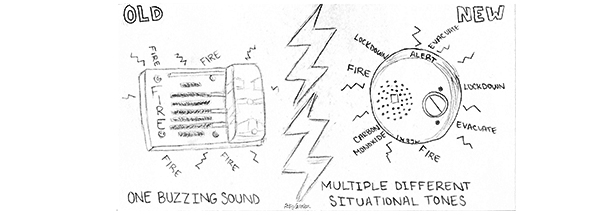New mass notification system improves security

Illustration by Patsy Carolan
November 12, 2018
A new mass notification system that plays tones to signify various emergency situations is currently being installed at South and is scheduled to be finished in early April of 2019, according to Casey Wright, associate principal for administrative services.
Wright says this new system will feature pre-recorded messages for fire alarm triggers, soft lockdowns, hard lockdowns, evacuations, carbon monoxide alerts, all clear announcements and relocation alerts. The old system was a hybrid system that had addressable and zoned areas, meaning that if an alarm went off in an addressable area, the exact location could be identified; but if it went off in a zoned area, a sector would be given instead of a specific location, according to Wright.
“If [the alarm] goes off in a zone, it makes it harder to identify the source of the problem, and that’s a safety concern,” Wright said. “[While the old system] is a safe system, it’s just not the most efficient.”
Plant Operator Brian Murdy says that the mass notification system is all new construction, so there will be new devices, speakers and wiring. The old system had one buzzing noise and strobe lights in some classrooms and hallways but the new system has multiple tones and strobe lights everywhere, Murdy explains. In the old system some smoke detectors were grouped together in a zone, so when one detector was triggered, all of them went off, which made the old system less efficient, Murdy says.
“In part of the school, the computer end of [the old fire alarm system] knew exactly where [the problem was], but in some areas, a bunch of smoke detectors were looped together,” Murdy said. “You could have had maybe 10 smoke detectors all looped together, and if one of them went off it would have set off the whole thing, so it could have been a zone of 10 different classrooms.”
The new mass notification system gives the exact room number of where the alarm was triggered for every room throughout the building, which is not something that the old system could do, Murdy states. The system is being installed by Esscoe, a company that is a security and fire alarm system integrator, Murdy says.
“If there’s a fire in a classroom, [the new system] will say exactly what classroom it’s in,” Murdy said. “Also, [there is] a monitor that has a map of the school, so for someone that’s not familiar with the school, they will be able to see the map, where the fire is and the exact classroom.”
Wright says that the estimated cost for the mass notification system is $1.3 million, but it is funded through South’s ongoing Life Safety project, and funds are allocated specifically to this area, Wright says.
Wright adds that the GBS administration is also looking into possible apps that could serve as another tool to communicate with students, parents and building officials, in addition to emails. He adds that this project is in an exploratory and research stage, so there is no set date for completion.
“If we had a threat like we recently had where there was a message that was found in a classroom, we look at our processes of what we do administratively in terms of communication and safety, and how could an app enhance that,” Wright said.
Principal Dr. Lauren Fagel mentions that the app could offer two-way communication so that students could quickly report information to administrators.
“It could also allow communication from students in a crisis to someone at the other end, so not just one-way communication, but if you have information to share like [if there was] an intruder in old pit,” Fagel said.
Wright explains that it is not just the GBS administration making decisions about the app; there are many levels of feedback that the app will go through before it gets implemented.
“There are lots of different processes that we’ll have to go through, not just with building leadership at South, but also with North, at the district level, with board members, student feedback and parent feedback,” Wright said. “There’s lots of different things that I think will help us make a good choice if we find something that makes sense, but we’re early in that conversation.”


